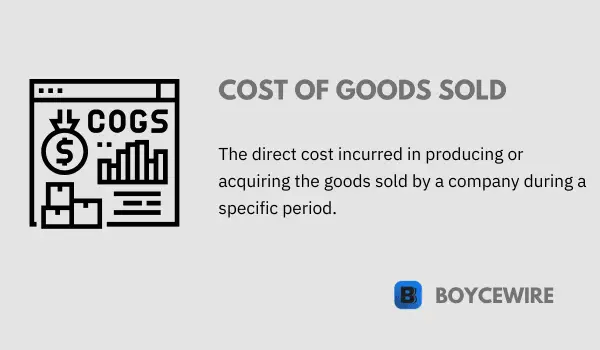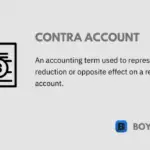Cost of Goods Sold: Definition, Formula & Examples

What is Cost of Goods Sold (COGS)?
In the world of business and accounting, understanding the true cost of producing and selling goods is critical to gauging a company’s profitability. One key metric used for this purpose is the Cost of Goods Sold, often abbreviated as COGS. It reflects the direct costs attributable to the production of the goods sold by a company, including costs of materials, direct labor costs, and direct factory costs in the case of a manufacturer.
Not only does it play a key role in determining a company’s gross profit, but it also provides insight into the efficiency of its production process and pricing strategies. This article delves into the concept of COGS, discussing its components, calculation methods, and significance in business operations, illustrated with real-world examples. Whether you’re a business owner, a budding accountant, or someone interested in corporate finance, understanding COGS is an essential part of your financial literacy.
Key Points
- Cost of Goods Sold (COGS) represents the expenses directly associated with producing or acquiring the goods sold by a company.
- COGS includes the cost of raw materials, direct labor, and other directly attributable costs incurred in the production or acquisition process.
- COGS is subtracted from the revenue generated from sales to determine a company’s gross profit.
Understanding Cost of Goods Sold (COGS)
The Cost of Goods Sold (COGS) is a line item on the income statement of a company. It reflects the cost of producing the goods or services that a company has sold during a particular period. So, what does COGS include? While this can vary somewhat by industry, it typically includes:
- Material Costs These are the costs of all the raw materials and parts required to create a product.
- Labor Costs These include the salaries and wages of the people directly involved in the manufacturing process.
- Overhead Costs These are the direct costs related to the production facility, such as rent, utilities, and maintenance expenses.
It’s crucial to understand that COGS only includes the direct costs of producing the goods or services a company sells. It does not include indirect expenses such as distribution costs, sales force costs, or marketing costs.
Understanding COGS is crucial as it is subtracted from a company’s revenues to determine its gross profit. A lower COGS will lead to a higher gross profit, assuming revenues remain constant. Conversely, a higher COGS will result in a lower gross profit. By analyzing COGS and its trends over time, companies can make informed decisions about pricing, sourcing materials, and efficiency in the production process.
Components of Cost of Goods Sold (COGS)
The cost of goods sold comprises several components that, together, reflect the total cost of producing and selling a product. Here are the main components of COGS:
- Direct Material Costs These are the raw materials that are directly involved in the production of goods.
- Direct Labor Costs These are the costs associated with the manpower directly involved in the production of goods.
- Manufacturing Overhead Costs These are indirect costs that are associated with manufacturing the product but cannot be directly linked to each unit produced.
- Shipping and Freight The costs associated with getting the raw materials to the production facilities and then delivering the final product to the point of sale.
These components combine to provide a comprehensive view of the costs incurred to produce the goods that a company sells. By understanding and managing these components effectively, companies can increase their gross margin and profitability.
How to Calculate Cost of Goods Sold (COGS)
The calculation of the Cost of Goods Sold (COGS) will depend on your inventory accounting method (like FIFO, LIFO, or average cost method), but the basic formula remains the same:
COGS = Beginning Inventory + Purchases during the period – Ending Inventory
Here is a more detailed explanation of each term:
- Beginning Inventory This is the value of all the products that a business has in its inventory at the start of the accounting period. It can include raw materials, work-in-progress, and finished goods, depending on the nature of your business.
- Purchases during the period This includes all the additional inventory that a business purchases during the accounting period. This might be raw materials for manufacturing businesses or finished goods for retailers. It could also include any direct labor or overhead costs that are directly tied to the production of goods.
- Ending Inventory This is the value of all the products that a business has in its inventory at the end of the accounting period.
By subtracting the ending inventory from the sum of beginning inventory and purchases, we can find the cost of goods sold. This calculation tells us how much it cost the company to produce the goods that were sold during that period.
Remember, COGS only includes the direct costs associated with producing the goods that a company sells, not indirect expenses like distribution costs, sales force costs, or marketing expenses.
Potential Errors in Calculating COGS
While calculating the Cost of Goods Sold (COGS), several errors can occur that might have significant implications for a company’s financial reporting and tax obligations. Here are some of the most common potential errors:
- Inventory Errors Inventory errors can lead to misstated COGS. If the beginning or ending inventory is incorrect, it will result in an incorrect COGS calculation. For instance, an overstatement of ending inventory will result in an understatement of COGS, and vice versa.
- Misclassification of Costs COGS includes only the direct costs associated with producing goods intended for sale. Misclassifying indirect costs such as selling, general, and administrative expenses as COGS can inflate the COGS figure.
- Incorrect Valuation of Inventory The method used for inventory valuation significantly impacts the calculation of COGS. Switching inventory valuation methods without proper disclosure or using an inappropriate method can lead to errors. For example, using the Last-In, First-Out (LIFO) method during deflationary times can lead to an overstatement of COGS.
- Failure to Adjust for Returns and Allowances If a company fails to adjust for goods returned by customers or allowances given for damaged goods, it could overstate its COGS.
- Omission of Direct Costs Failing to include all direct costs, such as direct labor or raw material costs, can result in an understatement of COGS.
- Failing to Write Down Obsolete Inventory Not writing down the value of obsolete or slow-moving inventory can overstate inventory value and understate COGS.
Each of these errors can distort a company’s financial picture, affecting the gross profit and net income reported on the income statement. In turn, this can mislead investors and other stakeholders. In the long run, it could also lead to regulatory scrutiny and possible penalties. Hence, it’s essential for companies to have robust internal controls and audit processes in place to ensure the accuracy of their COGS calculation.
Cost of Goods Sold (COGS) and the Income Statement
The Cost of Goods Sold (COGS) is a crucial line item on the income statement. The income statement, also known as the profit and loss statement, provides a detailed overview of a company’s revenues, costs, and expenses during a specific period.
The basic structure of an income statement is:
- Revenue/Sales The total amount of money generated by the sale of goods or services.
- Cost of Goods Sold (COGS) The direct costs attributed to the production of goods sold by a company. This includes both direct labor costs used to produce the good and the cost of raw materials used in production.
- Gross Profit This is calculated as Revenue – COGS. Gross profit measures a company’s manufacturing or production process efficiency.
- Operating Expenses These include all other expenses that aren’t included in COGS, such as selling, general, and administrative expenses (SG&A), depreciation, and amortization.
- Net Income This is the bottom line of the income statement, calculated as Gross Profit – Operating Expenses – Any Other Expenses (like interest or taxes).
Understanding COGS and its position on the income statement is vital. It directly impacts the calculation of gross profit, which is an indicator of a company’s profitability. A high COGS may suggest a company is not controlling its production costs effectively, resulting in lower gross profits and net income. Conversely, a low COGS relative to revenue can signify high gross profit margins, suggesting efficient production and cost control processes.
Therefore, effectively managing and accurately reporting COGS is crucial for understanding a company’s profitability, financial health, and operational efficiency.
Impact of Cost of Goods Sold (COGS)
The Cost of Goods Sold (COGS) is a vital measure for businesses, investors, and analysts. It directly impacts multiple aspects of a company’s operations and financial health. Here are the key areas impacted by COGS:
- Gross Profit Margin Gross profit margin is the gross profit made on sales, expressed as a percentage. It’s calculated by subtracting COGS from revenue and dividing the result by revenue. The lower the COGS, the higher the gross profit margin, indicating better profitability and efficiency.
- Inventory Valuation COGS directly affects the valuation of inventory, a crucial asset for any product-based business. An accurate COGS calculation ensures the inventory is correctly valued on the balance sheet.
- Pricing Strategy Understanding COGS helps in setting product pricing. To ensure profitability, businesses must price their goods or services above their total cost. A detailed breakdown of COGS can help in understanding the minimum price needed to cover costs and achieve desired profit margins.
- Performance Evaluation Changes in COGS can serve as an indicator of a company’s operational efficiency. For instance, an increase in COGS could indicate rising material costs, inefficient production processes, or wastage, necessitating operational changes.
- Tax Liability COGS is a deductible expense, which means it can reduce a company’s taxable income. Therefore, a higher COGS can lead to lower tax liability.
- Investment Decisions Investors and analysts use COGS to evaluate a company’s financial health and efficiency. A rising COGS without a corresponding increase in sales can be a red flag, suggesting potential issues such as inefficiency, increased competition, or rising production costs.
In sum, COGS not only impacts a company’s financial statements but also plays a crucial role in operational and strategic decision-making, tax planning, and investment analysis. An accurate and thorough understanding of COGS is thus essential for various stakeholders, from business managers to investors.
COGS and Tax Implications
The Cost of Goods Sold (COGS) plays a crucial role in determining a business’s taxable income and consequently its tax liability. Here’s how it does that:
- Deductible Expense The Internal Revenue Service (IRS) recognizes COGS as a business expense. It’s deducted from a company’s total revenues when calculating taxable income. So, the higher the COGS, the lower the taxable income, resulting in lower taxes.
- Inventory Valuation Methods The method used by a company to calculate COGS and value inventory has tax implications. The most common methods are FIFO (First-In, First-Out), LIFO (Last-In, First-Out), and weighted-average. During periods of inflation, the LIFO method usually results in a higher COGS and lower taxable income, potentially reducing a company’s tax liability. However, it’s important to note that once the LIFO method is chosen for tax purposes, the IRS requires it to be used in financial reporting as well.
- Tax Compliance An accurate calculation of COGS is critical for tax compliance. Companies must track and document all the costs involved in producing the goods sold during the year. This includes direct costs like raw materials and direct labor and certain indirect costs like factory overhead. Misreporting COGS can result in penalties and interest charges from the IRS.
- COGS Adjustment If a company discovers that COGS was under-reported or over-reported in a prior year, it can make an adjustment on its current year tax return, which will consequently affect its current year’s taxable income. Such adjustments must be disclosed and explained on the tax return.
- International Implications For companies operating in multiple countries, different tax jurisdictions might have different rules for calculating and deducting COGS. This can complicate the process and has implications for a company’s overall tax strategy.
In conclusion, COGS plays a significant role in shaping a company’s tax strategy and compliance. A sound understanding of how COGS influences taxable income and the tax rules associated with it is crucial for any business.
Examples of COGS Calculation
Understanding how to calculate COGS can be better illustrated with a few practical examples.
Example 1: A Clothing Retailer
Suppose a clothing retailer began the year with an inventory worth $20,000. During the year, it purchased additional inventory worth $50,000. At the end of the year, the inventory value was $10,000.
COGS = Opening Inventory + Purchases – Closing Inventory
COGS = $20,000 + $50,000 – $10,000 = $60,000
So, the Cost of Goods Sold for this retailer in that particular year is $60,000.
Example 2: A Car Manufacturer
Consider a car manufacturer who starts the year with an inventory valued at $500,000. The manufacturer purchases raw materials worth $1,000,000 during the year. By the end of the year, the manufacturer still has inventory valued at $300,000.
COGS = Opening Inventory + Purchases – Closing Inventory
COGS = $500,000 + $1,000,000 – $300,000 = $1,200,000
Therefore, the Cost of Goods Sold for this manufacturer in that particular year is $1,200,000.
It’s essential to note that these examples are simplified for clarity. In reality, businesses might use more complex methods to calculate COGS, considering factors like labor costs, overhead costs, and the method of inventory accounting (FIFO, LIFO, or Weighted Average), among other things. These methods should be consistently used from period to period, as inconsistent practices can distort the financial results.
FAQs
COGS stands for Cost of Goods Sold.
COGS is calculated by subtracting the value of ending inventory from the sum of beginning inventory and purchases during a specific period.
COGS is important because it directly impacts a company’s gross profit and overall profitability.
COGS specifically represents the direct costs associated with producing or acquiring goods, while operating expenses include other costs such as rent, salaries, and marketing expenses.
About Paul
Paul Boyce is an economics editor with over 10 years experience in the industry. Currently working as a consultant within the financial services sector, Paul is the CEO and chief editor of BoyceWire. He has written publications for FEE, the Mises Institute, and many others.

Further Reading
 Trade Deficit: Definition, Causes & Effects - A trade deficit occurs when a nation imports more goods than it exports. In other words, a nation buys more…
Trade Deficit: Definition, Causes & Effects - A trade deficit occurs when a nation imports more goods than it exports. In other words, a nation buys more…  Contra Account - A contra account is a type of account that is used to offset or reduce the balance of another related…
Contra Account - A contra account is a type of account that is used to offset or reduce the balance of another related…  Consumerism - Consumerism is a socio-economic ideology that promotes the acquisition and consumption of goods and services as a measure of individual…
Consumerism - Consumerism is a socio-economic ideology that promotes the acquisition and consumption of goods and services as a measure of individual… 